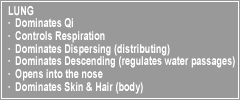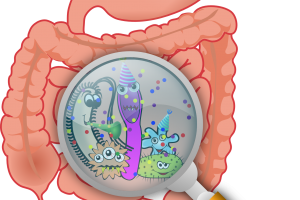Acupuncture 101 – Illuminations of the Lungs
part 4 of a 5 part series
Under the scope of acupuncture as a Traditional Chinese Medicine (TCM), pathways or meridians of Qi flow traverse the body and influence specific body regions, organ systems and functionality. Qi is considered a vital life force loosely translated as energy. When Qi is obstructed health imbalances result. The Lung meridian influences respiration and the production of Qi. This system has an important dispersing and descending action on Qi and the water qualities in the body. The Lung system opens to the nose and dominates the skin and body hair. Coughing, wheezing, post-nasal drip and mucus are typical signs of the Lung systems inability to disperse and descend. Some skin conditions, allergies besides the obvious respiratory ailments are often times imbalances in the Lung system. Cold constricts the Lungs ability to disperse and descend. Cold invades the body and constricts the body’s Guardian Qi circulation along the exterior surface of the skin.
 The common cold or flu translates as wind-cold or wind-heat invasion affecting the Lungs with typical signs of chills and fever. Diet therapy based on TCM defines pungent flavors to be beneficial to the Lung system. Pungent foods such as ginger, garlic and onions help ventilate the lungs and help restore the dispersing function. Pungent, warming foods warms the body, expands the guardian Qi and cause the body to sweat slightly. This is a sign that the exterior has been released along with any invading influences. Controversy stews over the benefits of chicken soup on the prevention and treatment for the common cold. My two questions in regards to any research on this matter would be as follows – Did they add a pungent ingredient to the soup recipe and did the patient sweat slightly to release the exterior?
The common cold or flu translates as wind-cold or wind-heat invasion affecting the Lungs with typical signs of chills and fever. Diet therapy based on TCM defines pungent flavors to be beneficial to the Lung system. Pungent foods such as ginger, garlic and onions help ventilate the lungs and help restore the dispersing function. Pungent, warming foods warms the body, expands the guardian Qi and cause the body to sweat slightly. This is a sign that the exterior has been released along with any invading influences. Controversy stews over the benefits of chicken soup on the prevention and treatment for the common cold. My two questions in regards to any research on this matter would be as follows – Did they add a pungent ingredient to the soup recipe and did the patient sweat slightly to release the exterior?
Christopher Carlow, D. Ac.Doctor of Acupuncture June 20, 2008








